Disturbances in Parallelly Operating PV Inverters While Islanding State Detection
Abstract
1. Introduction
2. Islanding Detection of PV Inverters
2.1. Description of the Laboratory Setup
2.2. The Method of Carrying out the Measurements
- (1)
- Launch of the network simulator.
- (2)
- Close the Q2 circuit breaker.
- (3)
- Turn on the photovoltaic panel simulator.
- (4)
- Close the Q1 circuit breaker.
- (5)
- Equalization of generated and load power.
- (6)
- Open the Q2 circuit breaker.
2.3. Test Condition According to Standards PN-EN 62116
2.4. Parallel Operation of Inverters
2.5. The Method of Carrying out the Measurements for Parallel Operation of Inverters
- (1)
- Launch of the network simulator.
- (2)
- Close the Q2 circuit breaker.
- (3)
- Turn on the photovoltaic panel simulator.
- (4)
- Switch on the inverter with battery energy storage.
- (5)
- Close the Q1 circuit breaker.
- (6)
- Equalization of generated and load power.
- (7)
- Open the Q2 circuit breaker.
3. Results
3.1. Time of Unintentional Islanding Detection for Single Inverter
3.2. Maximal Deviation of Parameters While Unintentional Islanding for a Single Inverter
3.3. Time of Unintentional Islanding for Parallelly Operating Inverters
4. Discussion on Possible Voltage Disturbances
4.1. Model of Two Parallel Grid-Following Inverters with Desynchronized PLLs
4.2. Possible Voltage Swells Based on the Results from Tested Inverters
5. Conclusions and Possible Solutions
Author Contributions
Funding
Data Availability Statement
Conflicts of Interest
Abbreviations
| ROCOF | Rate of Change of Frequency |
| AC | Alternating Current |
| DC | Direct Current |
| RMS | Real Mean Square |
| PV | Photovoltaic |
| FIR | Finite Impulse Response |
| PLL | Phase-Locked Loop |
References
- IEEE 1547.1-2020; IEEE Standard Conformance Test. In Procedures for Equipment Interconnecting Distributed Energy Resources with Electric Power Systems and Associated Interfaces. IEEE: Piscataway, NJ, USA, 2020.
- Abu Sarhan, M. An Extensive Review and Analysis of Islanding Detection Techniques in DG Systems Connected to Power Grids. Energies 2023, 16, 3678. [Google Scholar] [CrossRef]
- Abo-Khalil, A.G.; Abdalla, M.; Bansal, R.C.; Mbungu, N.T. A Critical Assessment of Islanding Detection Methods of Solar Photovoltaic Systems. Case Stud. Therm. Eng. 2023, 52, 103335. [Google Scholar] [CrossRef]
- Alobaid, M.; Abo-Khalil, A.G. A Comprehensive Review and Assessment of Islanding Detection Techniques for PV Systems. Int. J. Thermofluids 2023, 18, 100364. [Google Scholar] [CrossRef]
- Lerch, T.; Barczentewicz, S. Islanding Detection of Wind Power Plant with Doubly Fed Induction Generator. In Proceedings of the 2018 International Symposium on Electrical Machines (SME), Andrychów, Poland, 10–13 June 2018. [Google Scholar]
- Raza, S.; Arof, H.; Mokhlis, H.; Mohamad, H.; Illias, H.A. Passive Islanding Detection Technique for Synchronous Generators Based on Performance Ranking of Different Passive Parameters. IET Gener. Transm. Distrib. 2017, 11, 4175–4183. [Google Scholar] [CrossRef]
- Reddy, S.V.R.; Premila, T.R.; Reddy, C.R.; Alharbi, M.A.; Alamri, B. Passive Island Detection Method Based on Sequence Impedance Component and Load-Shedding Implementation. Energies 2023, 16, 5880. [Google Scholar] [CrossRef]
- Murugesan, S.; Venkatakirthiga, M. Active Unintentional Islanding Detection Method for Multiple PMSG Based DGs. IEEE Trans. Ind. Appl. 2020, 56, 3919–3931. [Google Scholar] [CrossRef]
- Sivadas, D.; Vasudevan, K. An Active Islanding Detection Strategy with Zero Non Detection Zone for Operation in Single and Multiple Inverter Mode Using GPS Synchronized Pattern. IEEE Trans. Ind. Electron. 2020, 67, 6570–6580. [Google Scholar] [CrossRef]
- Ropp, M.; Aaker, E.; Haigh, K.; Sabbah, J. Using Power Line Carrier Communication to Prevent Islanding. In Proceedings of the IEEE Photovoltaic Specialists Conference, Anchorage, AK, USA, 15–22 September 2000; pp. 1158–1161. [Google Scholar]
- Katyara, S.; Hashmani, A.; Chowdhary, B.S.; Musavi, H.B.; Aleem, A.; Chachar, F.A.; Shah, M.A. Wireless Networks for Voltage Stability Analysis and Anti-Islanding Protection of Smart Grid System. Wirel. Pers. Commun. 2021, 116, 1361–1378. [Google Scholar] [CrossRef]
- Wang, X.; Blaabjerg, F. Harmonic Stability in Power Electronic-Based Power Systems: Concept, Modeling, and Analysis. IEEE Trans. Smart Grid 2019, 10, 2858–2870. [Google Scholar] [CrossRef]
- Murugesan, S. A Hybrid Unintentional Islanding Identification Methodology for IIDGs. In Proceedings of the 2022 IEEE International Conference on Power Electronics, Drives and Energy Systems (PEDES), Jaipur, India, 14–17 December 2022; pp. 1–5. [Google Scholar]
- Resende, Ê.C.; Simões, M.G.; Freitas, L.C.G. Anti-Islanding Techniques for Integration of Inverter-Based Distributed Energy Resources to the Electric Power System. IEEE Access 2024, 12, 17195–17230. [Google Scholar] [CrossRef]
- Serrano-Fontova, A.; Casals Torrens, P.; Bosch, R. Power Quality Disturbances Assessment during Unintentional Islanding Scenarios: A Contribution to Voltage Sag Studies. Energies 2019, 12, 3198. [Google Scholar] [CrossRef]
- Choudhury, B.K.; Jena, P. Impedance Severity Index Based Hybrid Islanding Detection Approach for Zonal DC Microgrids. In Proceedings of the 2023 IEEE 3rd International Conference on Sustainable Energy and Future Electric Transportation (SEFET), Bhubaneswar, India, 9–12 August 2023; pp. 1–6. [Google Scholar]
- Chauhdary, S.T.; Khan, T.S.; Arif, S.; Ahmad, A.; Shah, M.A.; Baili, J. Microgrid Anti-Islanding Protection Scheme Based on Deep Neural Network Algorithm and Unscented Kalman Filtering. Sci. Rep. 2025, 15, 28726. [Google Scholar] [CrossRef] [PubMed]
- Sarhan, M.A.; Barczentewicz, S.; Lerch, T. Hybrid Islanding Detection Method Using PMU-ANN Approach for Inverter-Based Distributed Generation Systems. IET Renew. Power Gener. 2024, 18 (Suppl. S1), 4453–4464. [Google Scholar] [CrossRef]
- Bernstein, A.; Le Boudec, J.-Y.; Reyes-Chamorro, L.; Paolone, M. Real-Time Control of Microgrids with Explicit Power Set-Points: Unintentional Islanding. In Proceedings of the 2015 IEEE Eindhoven PowerTech, Eindhoven, The Netherlands, 29 June–2 July 2015; pp. 1–6. [Google Scholar]
- Wang, Y.; Tang, J.; Si, J.; Xiao, X.; Zhou, P.; Zhao, J. Power Quality Enhancement in Islanded Microgrids via Closed-Loop Adaptive Virtual Impedance Control. Prot. Control Mod. Power Syst. 2023, 8, 10. [Google Scholar] [CrossRef]
- PN-EN 62116:2014; Utility-Interconnected Photovoltaic Inverters—Test Procedure of Islanding Prevention Measures. Polish Committee for Standardization: Warsaw, Poland, 2014.
- Barczentewicz, S.; Lerch, T.; Bień, A.; Duda, K. Laboratory Evaluation of a Phasor-Based Islanding Detection Method. Energies 2021, 14, 1953. [Google Scholar] [CrossRef]
- Duda, K.; Zieliński, T.P.; Barczentewicz, S. Perfectly Flat-Top and Equiripple Flat-Top Cosine Windows. IEEE Trans. Instrum. Meas. 2016, 65, 1853–1864. [Google Scholar] [CrossRef]
- Duda, K.; Zieliński, T.P. FIR Filters Compliant with the IEEE Standard for M Class PMU. Metrol. Meas. Syst. 2016, 23, 63–74. [Google Scholar] [CrossRef]
- Wu, H.; Wang, X. Design-Oriented Transient Stability Analysis of PLL-Synchronized Voltage-Source Converters. IEEE Trans. Power Electron. 2020, 35, 3573–3589. [Google Scholar] [CrossRef]
- Gurugubelli, V.; Ghosh, A.; Panda, A.K. Parallel Inverter Control Using Different Conventional Control Methods and an Improved Virtual Oscillator Control Method in a Standalone Microgrid. Prot. Control Mod. Power Syst. 2022, 7, 29. [Google Scholar] [CrossRef]
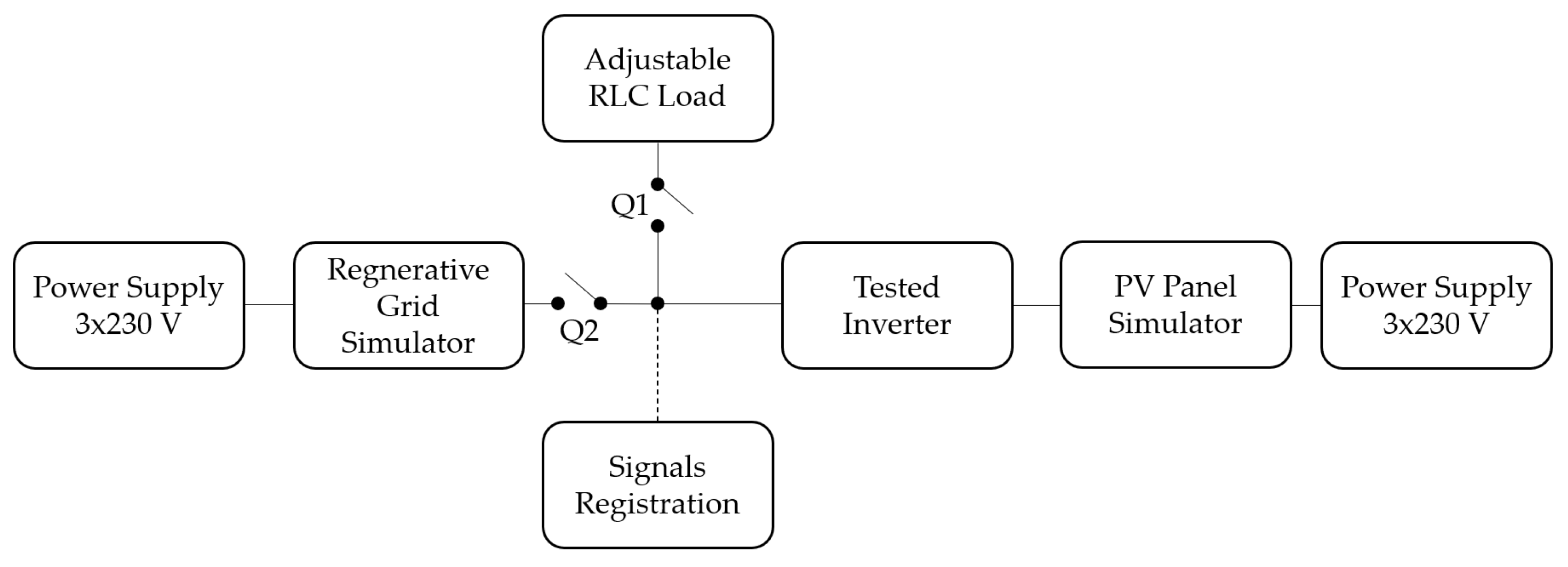
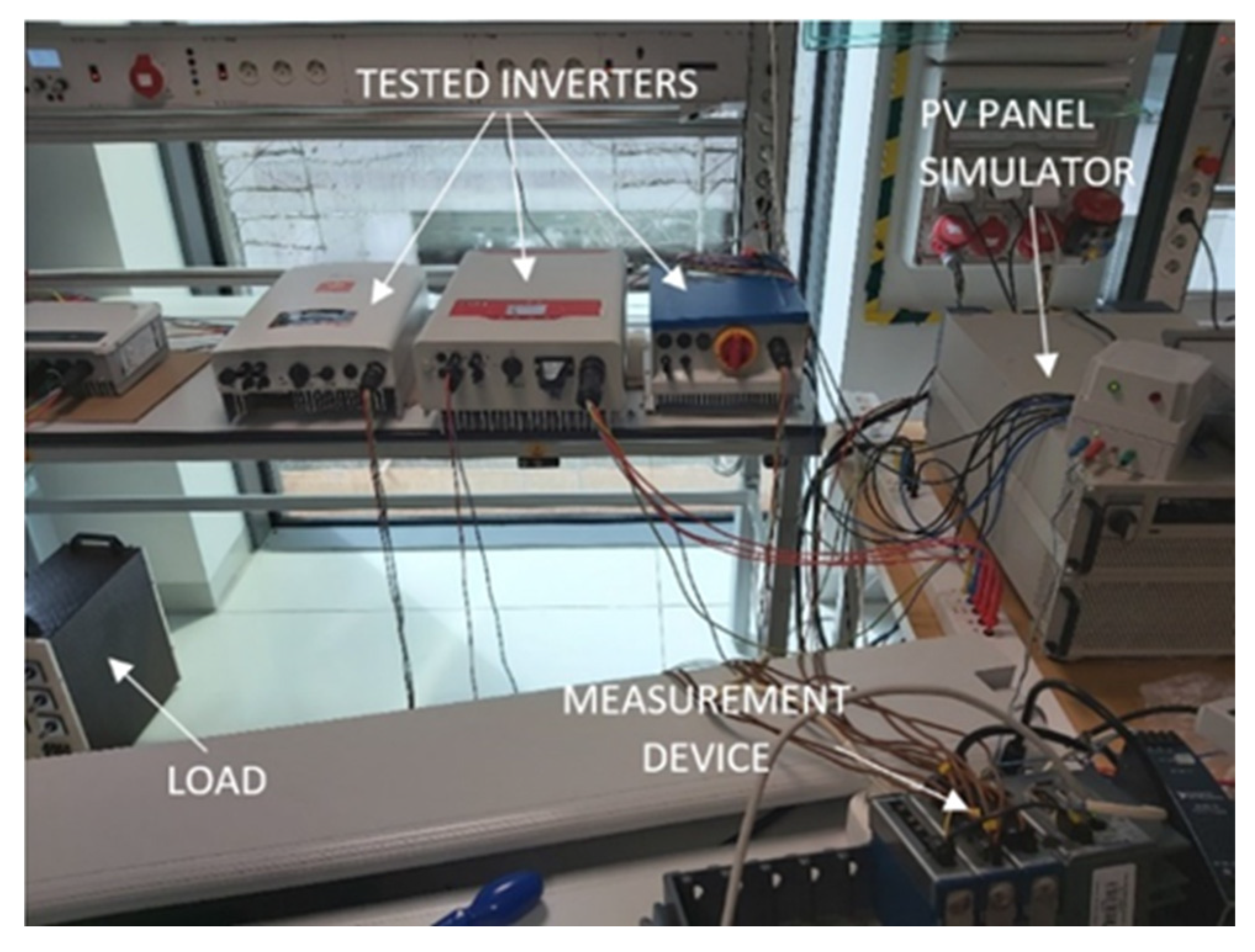
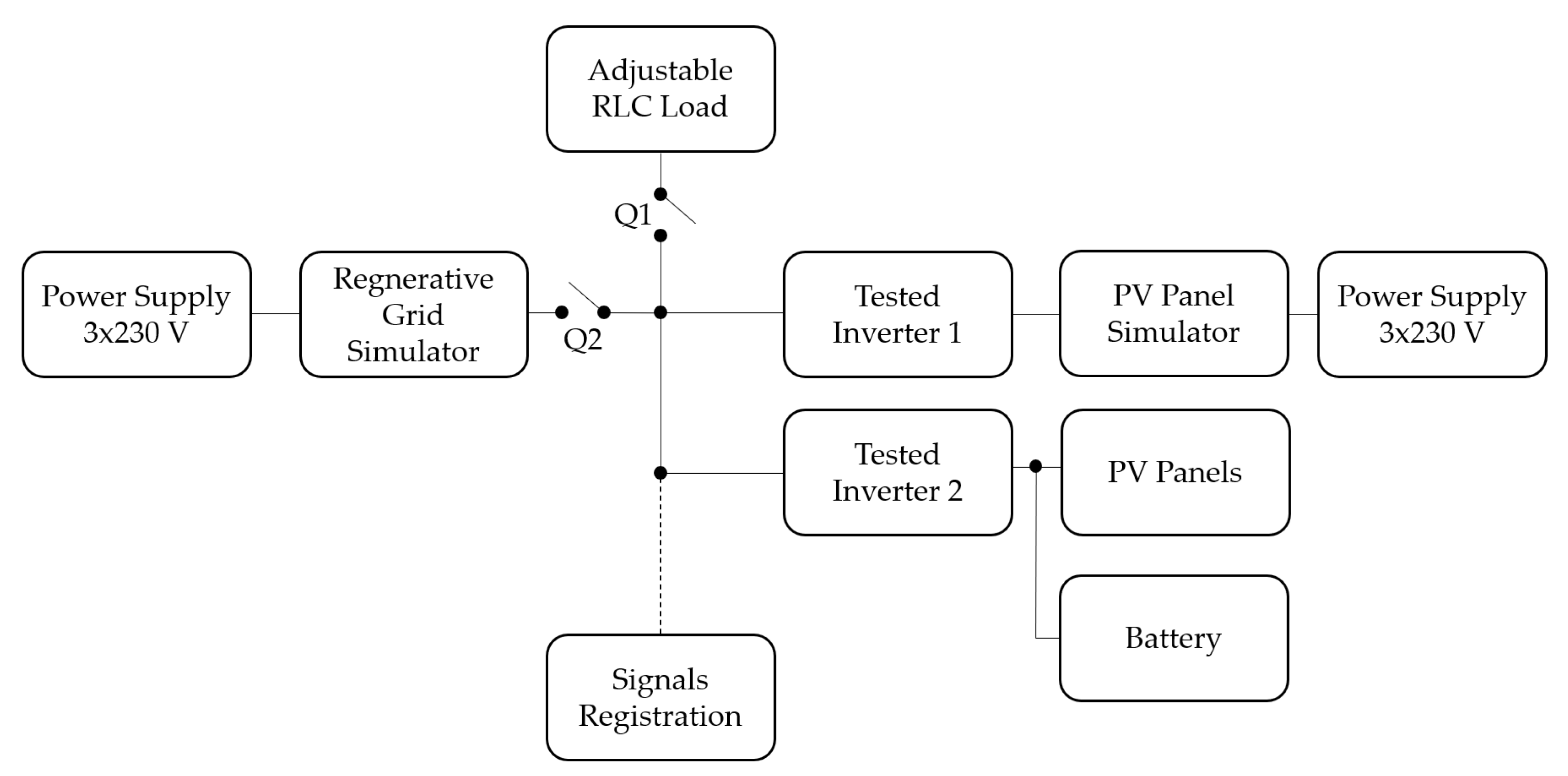
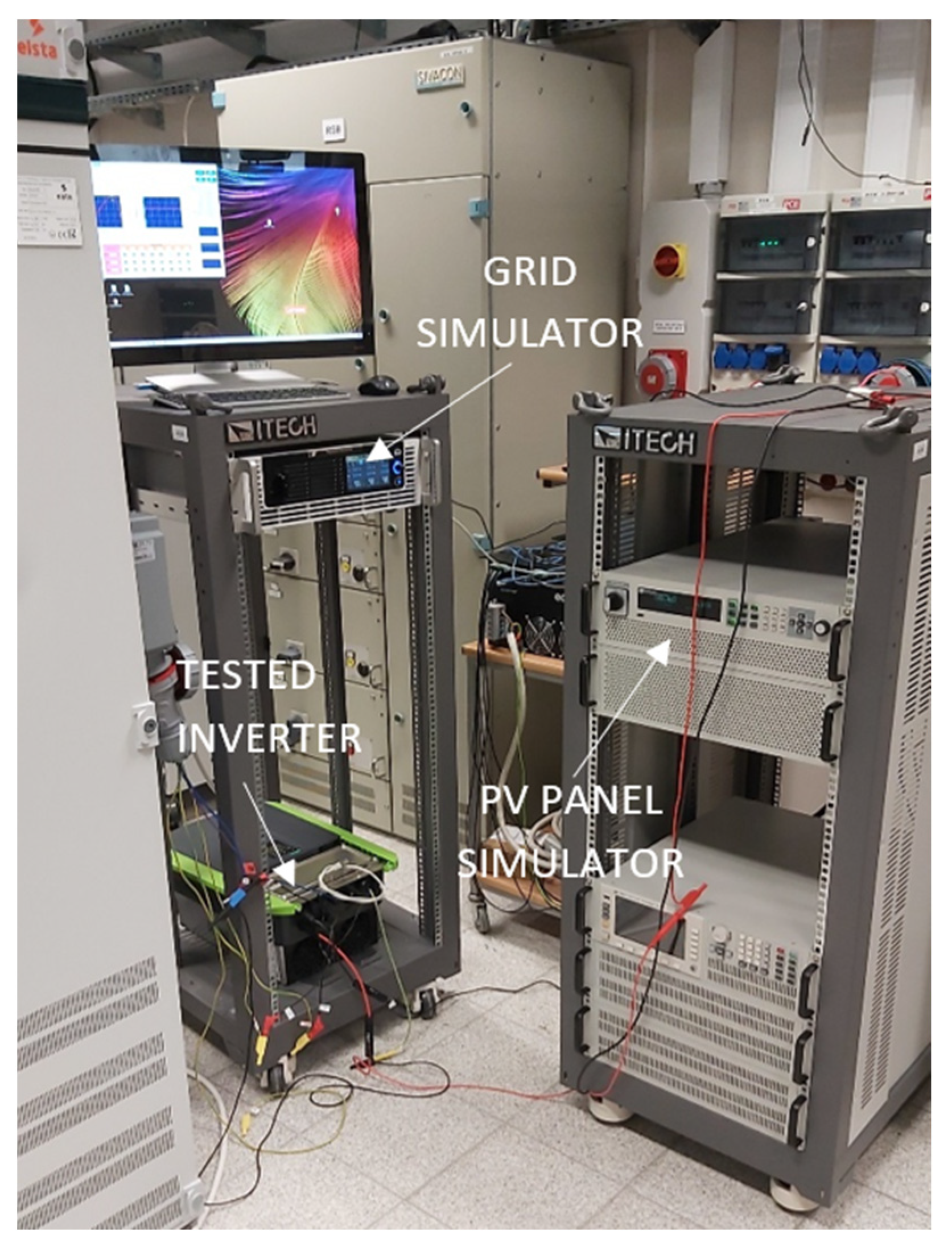
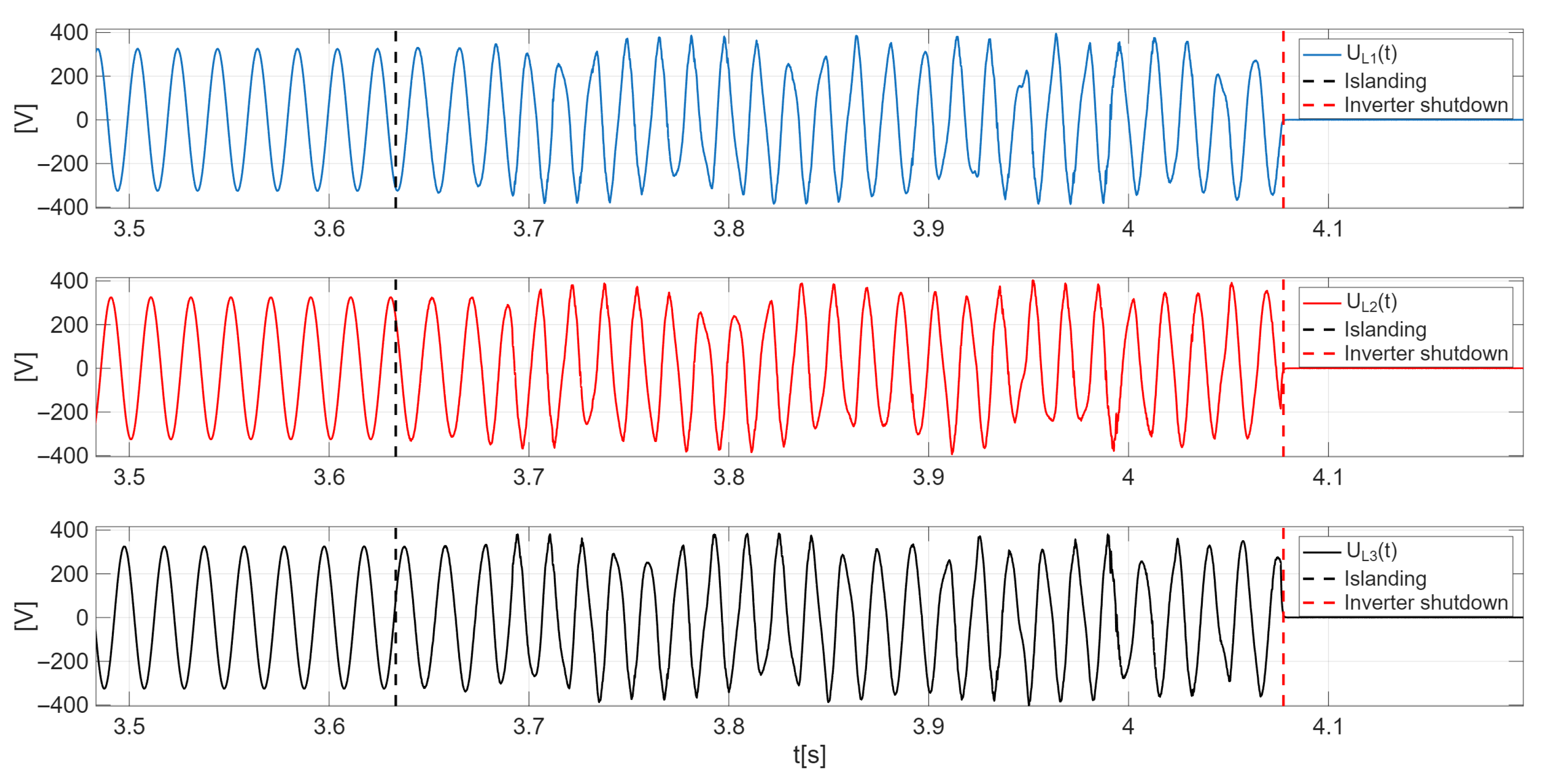
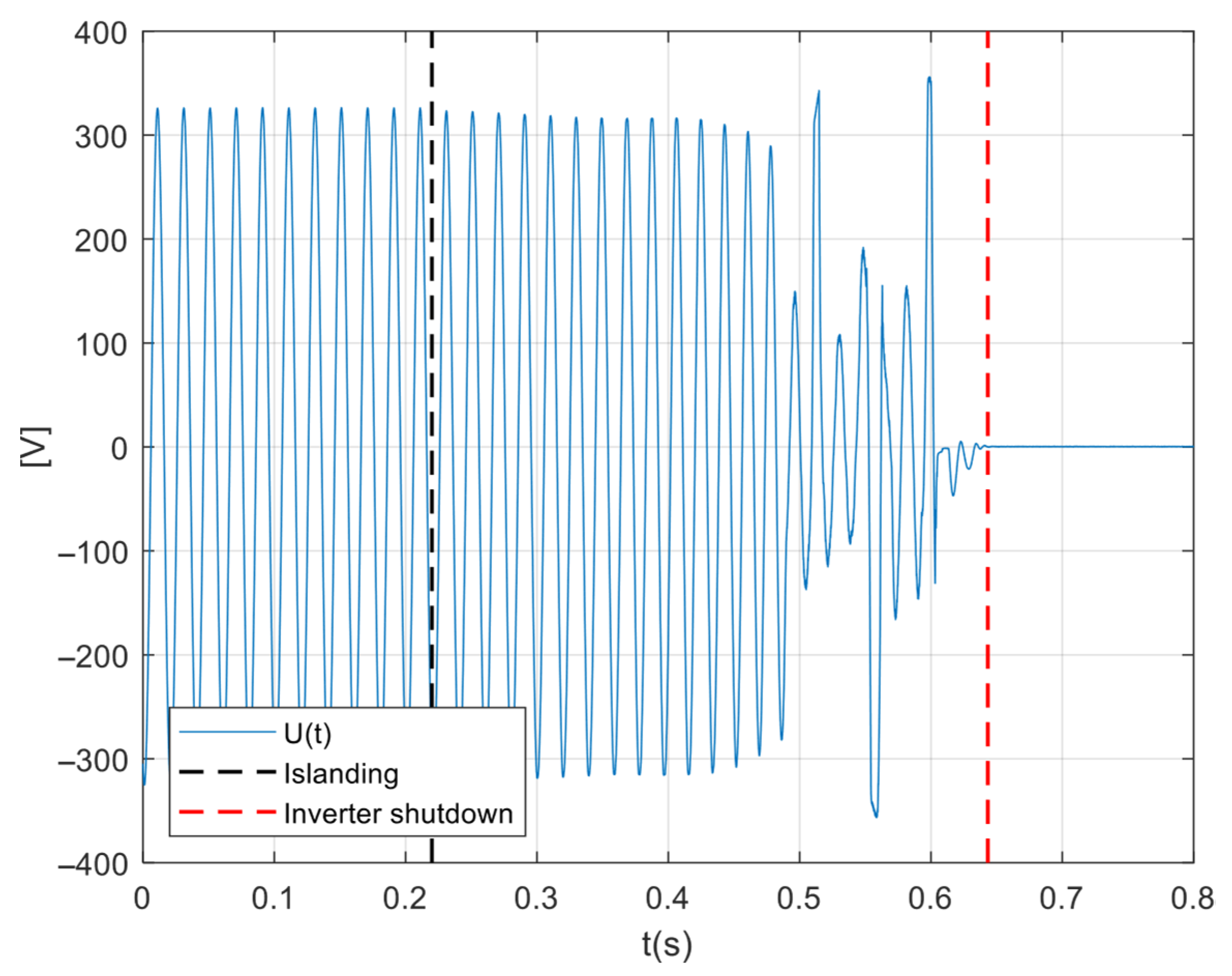
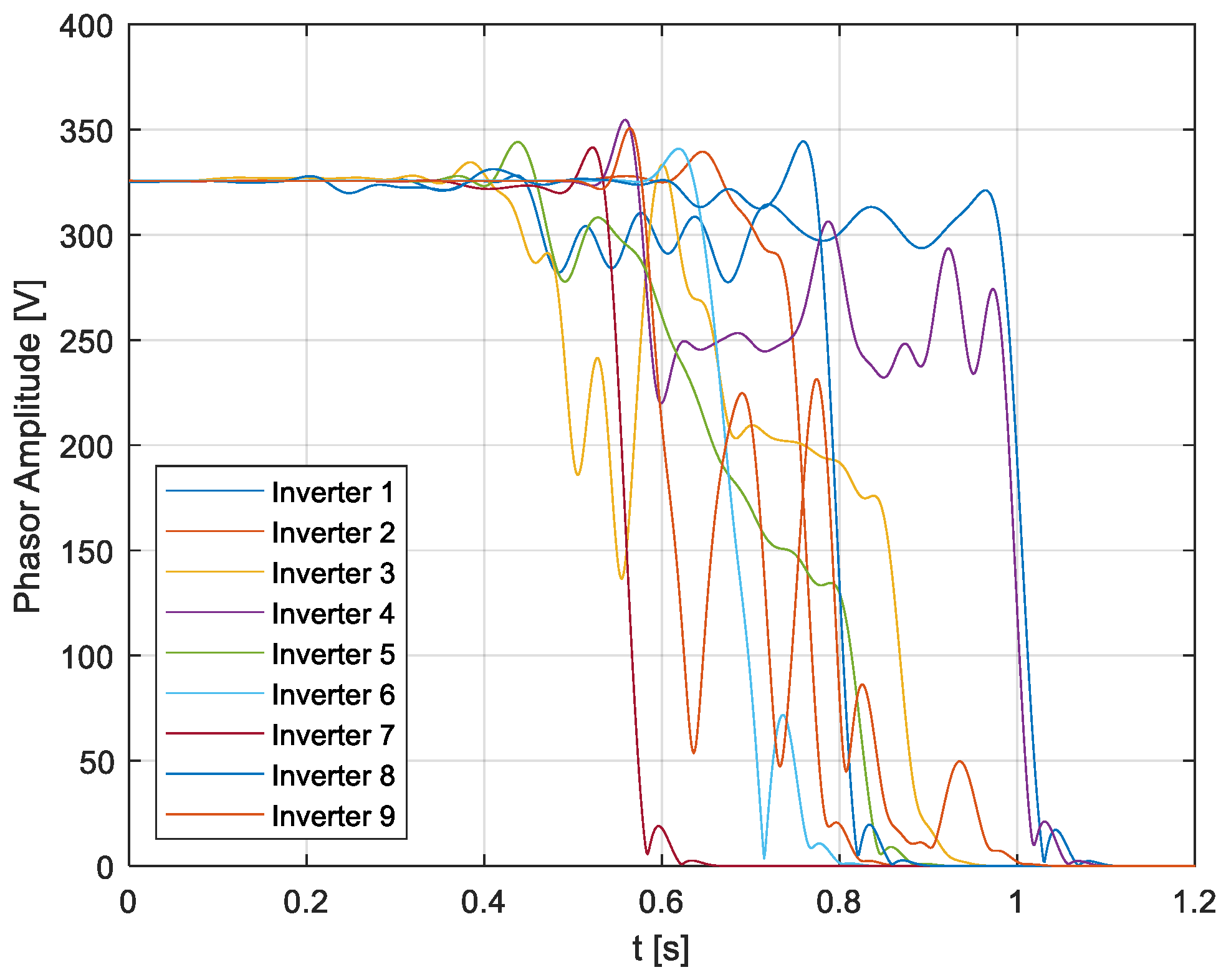

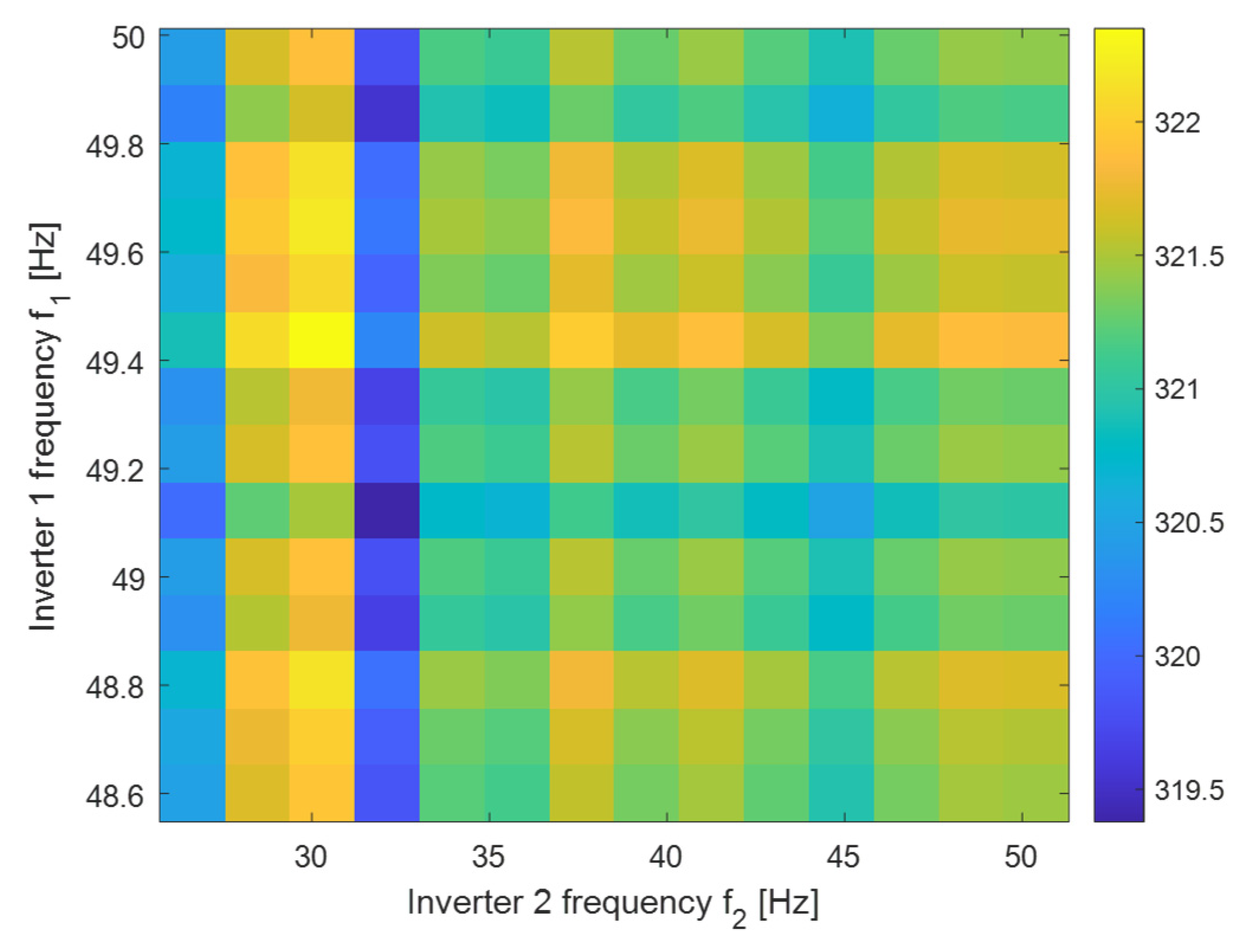
| Test | PEUT | PLOAD | PN-EN 62116 Standard |
|---|---|---|---|
| 1 | 100% | 100% | Table 9 no. 1 |
| 2 | 66% | 66% | Table 9 no. 2 |
| 3 | 33% | 33% | Table 9 no. 3 |
| 4 | 105% | 100% | Table 9 no. 5 |
| 5 | 95% | 100% | Table 9 no. 10 |
| Brand/Model | Rated AC Power [kW] | Type |
|---|---|---|
| AC INV-1P-37 (SolarEdge Technologies Ltd., Herzliya, Israel) | 3.7 | 1-phase |
| FoxESS F3600 (FoxESS, Wenzhou, China) | 3.6 | 1-phase |
| GoodWe GW3000-XS (GoodWe WRG, Guangde, China) | 3.0 | 1-phase |
| Growatt MOD 3600TL (Growatt, Shenzen, China) | 3.6 | 1-phase |
| Huawei SUN2000-3KTL-L1 (Huawei, Dongguan, China) | 3.0 | 1-phase |
| Kostal PIKO MP Plus 3.0-2 (Kostal Solar Electric GmbH, Freiburg, Germany) | 3.0 | 1-phase |
| Sofar Solar 2700TL-G3 (Shenzhen SOFARSOLAR Co., Ltd., Shenzhen, China) | 2.7 | 1-phase |
| SOLAX POWER X1 AIR (SolaX Power Network Technology (Zhejiang) Co., Ltd., Hangzhou, China) | 3.0 | 1-phase |
| Solis-1P3.6K-4G (Ginlong Technologies Co., Ltd., Ningbo, China) | 3.6 | 1-phase |
| Solplanet ASW3000-S (AISWEI Technology Co., Ltd., Yangzhong Economic Development Zone, China) | 3.0 | 1-phase |
| Sungrow SG2K5-S (Sungrow Power Supply Co., Ltd., Hefei, China) | 2.5 | 1-phase |
| TWERD PS100-PV (TWERD Energo Plus Sp. z o.o., Toruń, Poland) | 3.0 | 1-phase |
| TWERD PS3000-PV (TWERD Energo Plus Sp. z o.o., Toruń, Poland) | 5.0 | 1-phase |
| Afore Aton 6 (Afore New Energy Technology (Shanghai) Co., Ltd., Shanghai, China) | 6.0 | 3-phase |
| BBECO BBE-5-PL1 (Bruk-Bet PV Sp. z o.o., Żabno, Poland) | 5.0 | 3-phase |
| FoxESS T5 (FoxESS, Wenzhou, China) | 5.0 | 3-phase |
| Fronius Symo GEN24 6.0 (Fronius International GmbH, Sattledt, Austria) | 6.0 | 3-phase |
| GoodWe GW6K-DT (GoodWe WRG, Guangde, China) | 6.0 | 3-phase |
| Growatt MOD 6000TL3 (Growatt, Shenzen, China) | 6.0 | 3-phase |
| Huawei SUN2000-5KTL-M1 (Huawei, Dongguan, China) | 5.0 | 3-phase |
| KACO 5.0 TL3 (KACO new energy GmbH, Ba-den-Württemberg, Germany) | 5.0 | 3-phase |
| Kehua SPI6K-B (Xiamen Kehua Digital Energy Tech Co., Ltd., Xiamen, China) | 6.0 | 3-phase |
| Kostal Plenticore 5.5 3F (Kostal Solar Electric GmbH, Freiburg, Germany) | 5.5 | 3-phase |
| Sermatec SMT-6K-TL-TH (Sermatec Energy Technology Co., Ltd., Shanghai, China) | 6.0 | 3-phase |
| SMA STP6.0 (SMA Solar Technology AG, Niestetal, Germany) | 6.0 | 3-phase |
| SOLAX POWER X3 MIC (SolaX Power Network Technology (Zhejiang) Co., Ltd., Tonglu City, China) | 6.0 | 3-phase |
| Solis-3P6K-4G (Ginlong Technologies Co., Ltd., Ningbo, China) | 6.0 | 3-phase |
| Solplanet ASW5000-T (AISWEI Technology Co., Ltd., Yangzhong Economic Development Zone, China) | 5.0 | 3-phase |
| No. | Test 1 [ms] | Test 2 [ms] | Test 3 [ms] | Test 4 [ms] | Test 5 [ms] |
|---|---|---|---|---|---|
| 1 | - | 652 | 620 | 579 | 586 |
| 2 | 425 | 426 | 435 | 415 | 346 |
| 3 | 209 | 316 | 239 | 198 | 229 |
| 4 | 441 | 444 | 206 | 444 | 441 |
| 5 | 1506 | 1663 | 1561 | 1473 | 1456 |
| 6 | 1112 | 501 | 1423 | 2000+ | 1789 |
| 7 | - | 121 | 148 | - | 103 |
| 8 | 168 | 186 | 122 | 126 | 250 |
| 9 | 813 | 652 | 175 | 362 | 775 |
| 10 | 1546 | 1601 | 1167 | 1166 | 1546 |
| 11 | 82 | 79 | 84 | - | 85 |
| 12 | 603 | 777 | 1011 | 715 | 868 |
| 13 | 206 | 135 | 453 | 193 | 25 |
| 14 | 182 | 182 | 196 | 168 | 172 |
| 15 | 427 | 306 | - | - | - |
| 16 | 491 | 367 | 367 | 257 | 277 |
| 17 | 252 | 217 | 218 | 207 | 201 |
| 18 | 1024 | 1130 | 833 | 995 | 1334 |
| 19 | 2000+ | 2000+ | 2000+ | 2000+ | 2000+ |
| 20 | 722 | 747 | 1157 | 715 | 528 |
| 21 | 2000+ | 2000+ | 2000+ | 2000+ | 2000+ |
| 22 | 158 | 149 | 207 | 167 | 128 |
| 23 | 5 | 5 | 6 | 2 | 7 |
| 24 | 14 | 76 | 130 | 169 | 141 |
| 25 | 308 | 293 | 345 | 324 | 291 |
| 26 | 522 | 451 | 438 | 470 | 404 |
| 27 | 256 | 281 | 164 | 199 | 363 |
| 28 | 282 | 345 | 322 | 335 | 288 |
| No. | Test 1 [V] | Test 2 [V] | Test 3 [V] | Test 4 [V] | Test 5 [V] |
|---|---|---|---|---|---|
| 1 | - | 34 | 29 | 51 | 27 |
| 2 | 10 | 10 | 5 | 15 | 4 |
| 3 | 27 | 21 | 62 | 29 | 4 |
| 4 | 5 | 6 | 5 | 13 | 1 |
| 5 | 126 | 138 | 140 | 175 | 134 |
| 6 | 34 | 50 | 84 | 30 | 14 |
| 7 | 34 | 50 | 21 | 43 | 0 |
| 8 | 8 | 5 | 13 | 12 | 1 |
| 9 | 64 | 70 | 71 | 76 | 47 |
| 10 | 3 | 1 | 2 | 13 | 0 |
| 11 | 49 | 32 | 45 | 58 | 56 |
| 12 | - | 4 | 10 | - | 17 |
| 13 | 27 | 20 | 15 | 26 | 20 |
| 14 | 0 | 0 | 0 | 0 | 0 |
| 15 | 2 | 1 | 1 | 1 | 1 |
| 16 | 8 | 33 | 41 | 26 | 25 |
| 17 | 2 | 2 | 2 | 4 | 0 |
| 18 | 1 | 53 | 38 | - | 0 |
| 19 | 16 | 12 | 18 | 10 | 5 |
| 20 | 8 | 16 | 24 | 14 | 0 |
| 21 | 8 | 14 | 47 | 13 | 0 |
| 22 | 14 | 19 | 15 | 22 | 1 |
| 23 | 15 | 9 | 33 | 16 | 0 |
| 24 | 5 | 2 | 3 | 12 | 1 |
| 25 | 26 | 45 | 47 | 54 | 14 |
| 26 | 41 | 39 | 44 | 43 | 39 |
| 27 | 68 | 130 | - | - | - |
| 28 | 20 | 32 | 32 | 15 | 1 |
| No. | Test 1 [Hz] | Test 2 [Hz] | Test 3 [Hz] | Test 4 [Hz] | Test 5 [Hz] |
|---|---|---|---|---|---|
| 1 | - | 48.6 | 55.7 | 56.67 | 55.6 |
| 2 | 46.17 | 46.17 | 46.8 | 56.2 | 45.8 |
| 3 | 41.6 | 41.94 | 40.89 | 42.89 | 43.72 |
| 4 | 55.19 | 54.7 | 54.08 | 55.17 | 55 |
| 5 | 49.8 | 49.93 | 49.95 | 49.9 | 49.9 |
| 6 | 35.31 | 69.8 | 67.56 | 35.43 | 37.14 |
| 7 | 49.8 | 49.8 | 49.76 | 49.74 | 49.72 |
| 8 | 51 | 54.34 | 51.24 | 51.12 | 51 |
| 9 | 38.02 | 37.2 | 37.42 | 38.33 | 37.7 |
| 10 | 44.87 | 44.27 | 43.5 | 44.52 | 45.14 |
| 11 | 140 | 40.57 | 42.22 | 75 | 70.53 |
| 12 | - | 42.37 | 47.5 | - | 41.81 |
| 13 | 66.87 | 60.46 | 60.3 | 72.96 | 43.65 |
| 14 | 50.5 | 49.96 | 49.97 | 49.97 | 48 |
| 15 | 50.3 | 50.4 | 50.22 | 49.8 | 49.98 |
| 16 | 51.44 | 51.34 | 49.5 | 68 | 48.54 |
| 17 | 35.53 | 45.8 | 46 | 47.6 | 45.83 |
| 18 | 42.05 | 35.74 | 36.43 | - | 42 |
| 19 | 59.6 | 43.7 | 40 | 36.1 | 39 |
| 20 | 51.69 | 51.48 | 48.64 | 51.68 | 51.89 |
| 21 | 56.15 | 45.87 | 41 | 45.7 | 56.37 |
| 22 | 55.31 | 56.15 | 61 | 55.29 | 55.86 |
| 23 | 40.38 | 40.4 | 39.81 | 40.38 | 41.09 |
| 24 | 42.82 | 42.72 | 44.56 | 44.41 | 43.73 |
| 25 | 12.76 | 16.42 | 5.82 | 23.71 | 5.98 |
| 26 | 73.48 | 83.88 | 82.73 | 78.07 | 114.21 |
| 27 | 74.22 | 62.33 | - | - | - |
| 28 | 27.9 | 26.63 | 25.03 | −11.2 | 7.26 |
| Parameter | Inverter 1 | Inverter 2 | Inverters 1 + 2 |
|---|---|---|---|
| Time of reaction [ms] | 570 | 210 | 420 |
| Maximum voltage deviation [V] | 0 | 0 | 20 |
Disclaimer/Publisher’s Note: The statements, opinions and data contained in all publications are solely those of the individual author(s) and contributor(s) and not of MDPI and/or the editor(s). MDPI and/or the editor(s) disclaim responsibility for any injury to people or property resulting from any ideas, methods, instructions or products referred to in the content. |
© 2025 by the authors. Licensee MDPI, Basel, Switzerland. This article is an open access article distributed under the terms and conditions of the Creative Commons Attribution (CC BY) license (https://creativecommons.org/licenses/by/4.0/).
Share and Cite
Barczentewicz, S.; Lerch, T.; Wetula, A. Disturbances in Parallelly Operating PV Inverters While Islanding State Detection. Energies 2025, 18, 5556. https://doi.org/10.3390/en18215556
Barczentewicz S, Lerch T, Wetula A. Disturbances in Parallelly Operating PV Inverters While Islanding State Detection. Energies. 2025; 18(21):5556. https://doi.org/10.3390/en18215556
Chicago/Turabian StyleBarczentewicz, Szymon, Tomasz Lerch, and Andrzej Wetula. 2025. "Disturbances in Parallelly Operating PV Inverters While Islanding State Detection" Energies 18, no. 21: 5556. https://doi.org/10.3390/en18215556
APA StyleBarczentewicz, S., Lerch, T., & Wetula, A. (2025). Disturbances in Parallelly Operating PV Inverters While Islanding State Detection. Energies, 18(21), 5556. https://doi.org/10.3390/en18215556







